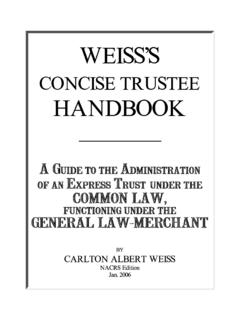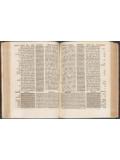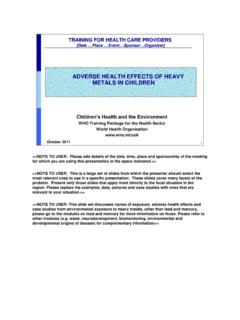Transcription of DICTIONARY OF BIBLICAL HEBREW - sdbh.org
1 TOWARDS A NEW DICTIONARY OF BIBLICAL HEBREW BASED ON SEMANTIC DOMAINS Reinier de Blois United Bible Societies Woerden (Utr.), The Netherlands 1. INTRODUCTION In the course of the years many dictionaries of BIBLICAL HEBREW have been published. New dictionaries are on their way. Lexicographical insights have changed a lot over the past years, however. This paper deals with the question as to what extent modern lexicographic insights can be used in ( BIBLICAL ) HEBREW lexicography. Traditional Approaches One of the key questions in semantics, that needs to be answered before anybody can embark on the enormous and tedious task of creating a lexicon of BIBLICAL HEBREW , is the following: How do we find out the meaning of a particular word? If we study some of the more traditional HEBREW dictionaries we can see that a number of criteria have been used to determine the meaning of a particular entry or subentry.
2 Let us briefly look into those criteria and try to evaluate them. 1. Etymology This is information about a particular word on the basis of internal reconstruction, whether or not sometimes with the help of data from related languages. If, for instance, we compare the meaning of a particular word with the meaning of the root from which it seems to have been derived, we can draw all kinds of conclusions about the possible meaning of that word. Although a word study of this nature may provide us with useful information, its significance is often overemphasized. As we will see later, the real meaning of a word is discovered when we study it in its context in the largest possible sense of the word. There are numerous cases of wrong exegesis of BIBLICAL passages because of the fact that the exegete leaned too heavily on the etymology of a particular word. 2. Comparative Linguistics Our knowledge of BIBLICAL HEBREW has benefited immensely over the last centuries from discoveries of manuscripts and inscriptions in related languages, some of which were not even known to exist before those days.
3 The decipherment of those texts yielded a treasure of new insights in the linguistic mosaic of the ancient Middle-East and helped to discover other meanings for certain HEBREW words that had hitherto been hard to interpret. Again, this is important information as it can be used to substantiate the claims of the author(s) of the DICTIONARY that a particular word must have meaning A rather than meaning B. In spite of this, however, one has to be very careful with this information, as it originates from different languages with different underlying world views and cultures, and --in many cases-- with only a limited data corpus. Moreover, a word has meaning only within its own language and its own period of usage (Barr 1992:141) and the primary method for determining the meaning of a word is by studying it within the context of all passages where it is found. 3. Semantic Analysis The dictionaries listed above usually contain some degree of semantic analysis.
4 The gloss that is considered to represent the main or basic meaning of a particular entry usually precedes the glosses that point to meanings that are understood to be its derivatives. Unfortunately, however, a structural semantic analysis is often lacking. This is a detailed study of the way different concepts in the world behind a language are perceived by the speakers of that language and how these concepts are transferred into semantic forms. Such a study gives us a lot of insight in the meaning of words and the ways different meanings interrelate. As Barr (1992:143) observes, however, the semantic analysis of the older dictionaries seems often to be defective and needs to be rethought. 4. Syntagmatic Relations Dictionaries often contain a certain amount of syntagmatic information as well. Words may take on a different shade of meaning when occurring in certain constructions, like idiomatic expressions.
5 It may sometimes be important to know which preposition a particular verb requires or whether it is followed by an infinitive or not. This, however, is syntactic information and not of the same nature as semantic information. Many of the traditional dictionaries, though, come up with mixtures of syntactic and semantic data which may mislead the user and keep him/her from gaining a clear insight in the meaning of a particular word Definitions vs. Glosses The major weakness of many of the traditional HEBREW dictionaries, however, lies in the fact that, instead of giving the meaning of a particular HEBREW word, usually not more than one or more glosses of that word in the target language are given. This actually does not apply to HEBREW dictionaries only, but to many traditional dictionaries of other languages as well. This is a pity because a set of glosses only gives a limited insight in the meaning of a particular word.
6 Glosses, according to Barr (1973:119-120), are not themselves meanings nor do they tell us the meanings; the meanings reside in the actual HEBREW usage, and for real semantic analysis the glosses have no greater value than that of indicators or labels for a meaning which resides in the HEBREW itself . The use of glosses can even be misleading. If a certain entry in a particular DICTIONARY is listed with three glosses the average reader may get the impression that that entry has three meanings even though those three glosses may be practically synonyms of each other. If we want to know the meaning of a word we need much more information than can be contained in a simple gloss. It is interesting to note that a number of monolingual dictionaries handle their entries in a much better way. This type of DICTIONARY usually explains the meaning of each word by means of a definition.
7 A good example of such a DICTIONARY is The Concise Oxford DICTIONARY (Sykes 1983). Many people, however, seem to think that the only reason why dictionaries of this category make use of definitions rather than glosses lies in the fact that these are monolingual dictionaries and certain words simply do not have the synonyms that could function as glosses. But according to Wierzbicka (1985:5), when it comes to concepts encoded in words of a foreign language, especially a culturally distant one, the intuitive link between a word and a concept is missing, and a full definition is the only way of ensuring true understanding of the cultural universe encoded in the language s lexicon. Analysis of Meaning But before we can write a definition for a particular entry we have to establish the methodology that is to be followed in order to do this well. The meaning of a word is not automatically equivalent to a long description with a large quantity of encyclopedic information, which, according to Louw (1985a:58) does not explain the meaning of the word but elaborates on the concept or the object involved.
8 As Nida correctly observes, words have meaning only in terms of systematic contrasts with other words which share certain features with them but contrast with them in respect to other features (Nida 1975a:32). In other words, each particular word is a member of a larger group of words that have certain aspects of meaning in common. Such a group can be called a semantic field or a semantic domain. The meaning of a word can only then be fully understood when we study it in combination with other words that belong to the same semantic domain. This means that before we can write a DICTIONARY of a particular language we need to start with a set of semantic domains. The next question that comes to mind, then, is the following: From where do we get those semantic domains? Is there a universal set of semantic domains that can be applied to every individual language? Unfortunately, things are not as simple as that.
9 If the meaning of a word were only a relation to a particular entity in the practical world we would probably be able to come up with an universal set of domains. This is not the case, however. As Nida (1975b:14) observes, the meaning of a word relates to a concept or a set of concepts that people have about an entity or a set of entities in the world around them. And these concepts may vary from one language or culture to another. For that reason each individual language requires a thorough and structural semantic study before we can even make the slightest effort towards producing a DICTIONARY in that language. This becomes very crucial for translators in cases where there are significant differences in culture and world view between the source and target language. A HEBREW -English DICTIONARY is such a case, even more so because of the fact that the text of the HEBREW Old Testament with its corresponding world view is more than 2000 years old.
10 2. EXISTING HEBREW DICTIONARIES One of the oldest dictionaries that are still actively used by HEBREW scholars is the one by Gesenius. This and a number of more recent dictionaries will be discussed in more detail below. Gesenius A classic HEBREW DICTIONARY is the one by Dr. Heinrich Friedrich Wilhelm Gesenius, of which the first edition was published around 1810, and which was written in the German language. Even long after his death in 1842, many revisions, translations, and reprints of this classic work appeared. This DICTIONARY contains a treasure of information, including cognates from related languages and references to other scholarly publications, but cannot be considered fully up-to-date anymore. Brown-Driver-Briggs Another well-known DICTIONARY is the one by Brown, Driver, and Briggs, of which the first part was published in 1891 and completed in 1906. Their work was written in English and based on Robinson s translation into English of Gesenius DICTIONARY , which came out in 1854.





